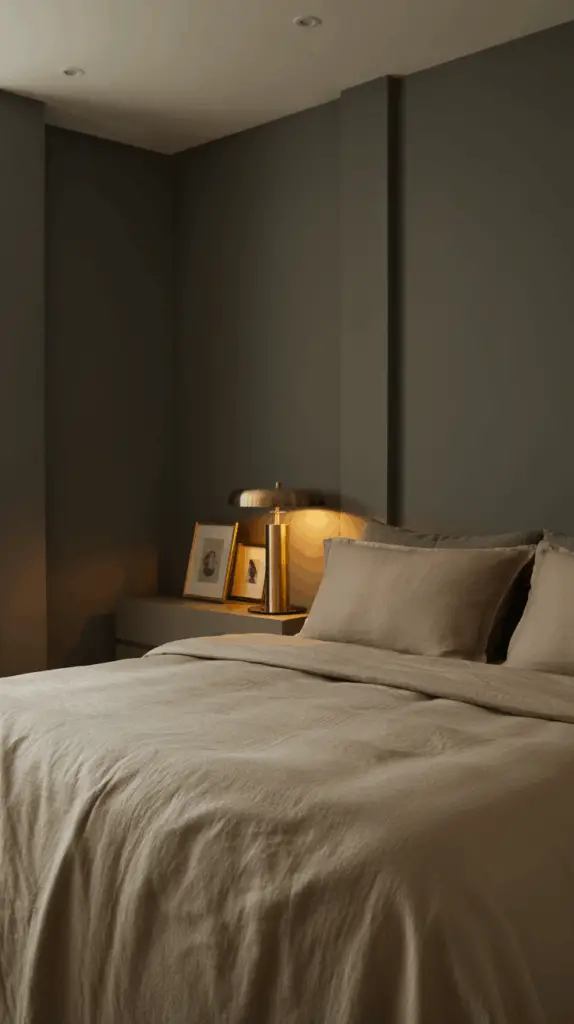Minimalist Approach to a Moody Neutral Bedroom That Feels Rich and Timeless
Table of Contents
Introduction
There’s something irresistibly captivating about a moody neutral bedroom. It’s sophisticated without being cold, minimalist without feeling bare, and rich without being flashy. Recent interior design trends show a 40% rise in homeowners choosing darker, neutral palettes for their bedrooms—a sign that people crave spaces that feel grounded, cozy, and serene.
But here’s the challenge: how do you make a minimalist bedroom feel warm and luxurious rather than stark and lifeless? The answer lies in balance—pairing depth and texture with restraint and simplicity. A moody neutral bedroom thrives on tactile materials, muted tones, layered lighting, and curated decor.
In this article, we’ll explore how to achieve a minimalist yet indulgent space where every element serves a purpose. You’ll learn how to build a cohesive color palette, play with light and texture, and integrate understated details that elevate the entire room. By the end, you’ll know how to transform your bedroom into a refined retreat that embodies quiet luxury and calm sophistication.
Defining the Moody Neutral Aesthetic
A moody neutral bedroom draws inspiration from shadows, earthy tones, and tactile finishes. It’s not just about painting the walls gray or beige—it’s about layering warmth and contrast to create a space that feels alive and balanced.
The palette typically includes taupe, charcoal, soft black, mushroom, ivory, and deep brown. The key is to use tone-on-tone layering rather than stark contrast. When done right, even darker colors feel calm and inviting rather than heavy or oppressive.
Textures are equally essential to the look. Natural materials like linen, wool, leather, and wood ground the space, while matte finishes and diffused lighting enhance the moody ambiance. The style is minimalist, but not austere—it invites touch and comfort without unnecessary decoration.
| Core Element | Description | Design Impact |
| Color Palette | Taupe, charcoal, mocha, ivory | Creates balance and depth |
| Material | Linen, wool, wood, metal | Adds natural warmth |
| Lighting | Soft, ambient sources | Enhances the mood |
| Texture | Layered surfaces | Prevents visual flatness |
Building a Balanced Color Palette
A moody neutral bedroom begins with color. The goal is to design a palette that feels cohesive, not cluttered. Start with a deep, grounding base—such as soft black, espresso brown, or charcoal gray—and build lighter tones around it for contrast and dimension.
Your walls can set the tone. A matte finish in a warm gray or mushroom shade creates instant sophistication. Complement it with bedding and decor in lighter neutrals like taupe, sand, or ivory. This layering of tones allows light to move subtly through the space, adding richness without clutter.
When choosing accents, avoid overly bright or cool tones that disrupt the calm. Instead, incorporate muted hues like olive, camel, or stone. These slight shifts in color add interest while maintaining serenity.
| Palette Level | Example Colors | Suggested Use |
| Base | Charcoal, espresso | Walls or furniture |
| Mid | Taupe, mushroom | Bedding or curtains |
| Light | Ivory, sand | Accents or trim |
| Accent | Olive, brass | Accessories or decor |

Playing with Texture for Visual Richness
Texture is the soul of a minimalist, moody space. Since the palette is restrained, layering materials becomes essential for adding warmth and personality.
Mix smooth and rough textures for balance. For example, pair a matte painted wall with a plush wool rug, or combine crisp linen bedding with a velvet throw. The key is subtle contrast—you want your textures to whisper luxury, not shout it.
Natural materials anchor the mood. A reclaimed wood nightstand or a woven jute rug grounds the sleek lines of modern furniture. Soft textiles like cashmere or brushed cotton add comfort, making the room feel lived-in rather than staged.
Lighting also interacts with texture—matte finishes absorb light beautifully, while metallic accents reflect it softly, adding dimension without sparkle.
| Texture Type | Material | Best Placement |
| Soft | Linen, velvet, cashmere | Bedding, curtains |
| Natural | Wood, jute, stone | Furniture, rugs |
| Matte | Wall finishes, ceramics | Surfaces and accessories |
| Reflective | Brushed brass, glass | Lighting and decor |
The Role of Lighting in a Moody Minimalist Bedroom
Lighting can make or break a moody neutral bedroom. The goal is to create layers of light that feel warm, atmospheric, and calming. Harsh overhead lights can flatten the space, so focus on diffused, directional, and accent lighting instead.
Start with ambient light—wall sconces or hidden LED strips behind a headboard add a soft glow without overwhelming brightness. Layer in task lighting like adjustable bedside lamps with warm-toned bulbs. For depth, add accent lights such as candles, lanterns, or floor lamps that highlight texture and color.
The color temperature of light is crucial. Opt for bulbs between 2200K and 2700K for a soft, golden tone. Avoid cool white light—it disrupts the richness of moody neutrals and creates an unnatural glare.
| Lighting Type | Example | Function |
| Ambient | Wall sconces, concealed LED | Base glow for relaxation |
| Task | Reading lamps | Practical focused light |
| Accent | Floor lamp, candles | Mood enhancement |
| Natural | Filtered daylight | Complements earthy tones |
Minimalist Furniture Choices That Feel Luxurious
Minimalist doesn’t mean sparse—it means intentional. In a moody neutral bedroom, every piece of furniture should serve both form and function. Choose designs with clean lines and natural finishes, avoiding overly ornate details.
A low-profile bed frame in oak, walnut, or black-stained wood creates a modern base. Pair it with floating nightstands or slender side tables to maintain visual lightness. Upholstered headboards in linen or suede can add softness and luxury without clutter.
Storage should blend seamlessly into the space. Built-in wardrobes or minimalist dressers with matte finishes work best. Keep hardware simple—matte black or brushed brass knobs complement the palette beautifully.
| Furniture Piece | Material | Design Style | Purpose |
| Bed Frame | Wood or metal | Low-profile, clean lines | Central statement |
| Nightstand | Oak or walnut | Floating or minimal base | Functionality |
| Wardrobe | Painted or natural wood | Built-in or sleek | Hidden storage |
| Chair/Bench | Linen or leather | Simple silhouette | Comfort and balance |
Layering Textiles for Depth and Comfort
Even in a minimalist design, layering textiles adds the feeling of abundance and warmth. The right fabrics can turn a simple neutral room into a luxurious haven that feels inviting year-round.
Start with bedding: choose high-quality sheets in soft neutrals like ivory or sand. Layer a quilt or linen duvet for breathability, then add a heavier throw in wool or velvet for depth. Stick to a restrained color palette—too many tones can break the calm visual flow.
Curtains play a major role in setting the mood. Opt for floor-to-ceiling drapes in linen or cotton blends for softness. A layered rug approach—placing a small wool rug over a larger jute base—creates dimension underfoot and defines the sleeping zone.
| Textile Type | Ideal Fabric | Function |
| Bedding | Linen, cotton sateen | Soft comfort |
| Throws | Wool, velvet | Visual depth |
| Curtains | Linen blend | Soft diffusion of light |
| Rugs | Wool, jute | Grounding and warmth |
Curating Art and Accessories with Intention
Accessories in a minimalist, moody bedroom should feel purposeful. Too many objects disrupt the serenity; too few can make the space feel sterile. The key is curation—choosing items that enhance mood and texture rather than distract.
Artwork should align with the palette and emotion of the room. Abstract pieces in muted tones—like soft blacks, warm grays, or sepia—add depth without stealing focus. Consider framed black-and-white photography for timeless appeal.
When it comes to accessories, think tactile. Ceramic vases, stone trays, or sculptural decor pieces introduce subtle contrast. Use greenery sparingly—perhaps a single vase with olive branches or dried stems.
| Item Type | Suggested Material | Placement |
| Artwork | Canvas, photography | Above bed or side wall |
| Vases | Ceramic, glass | Bedside or console |
| Mirrors | Aged or matte metal | Reflect natural light |
| Plants | Olive, dried florals | Adds organic life |
Conclusion
A minimalist approach to a moody neutral bedroom is about restraint and richness existing in harmony. Every element—from the muted color palette to the layered textures—contributes to a space that feels grounded, sophisticated, and serene.
By focusing on balance rather than excess, you create a bedroom that radiates quiet confidence. Natural materials, soft light, and thoughtful design choices turn simplicity into luxury. The result isn’t just beautiful—it’s deeply comforting.
Your moody neutral retreat becomes more than a room; it’s an experience of stillness, warmth, and timeless elegance.

